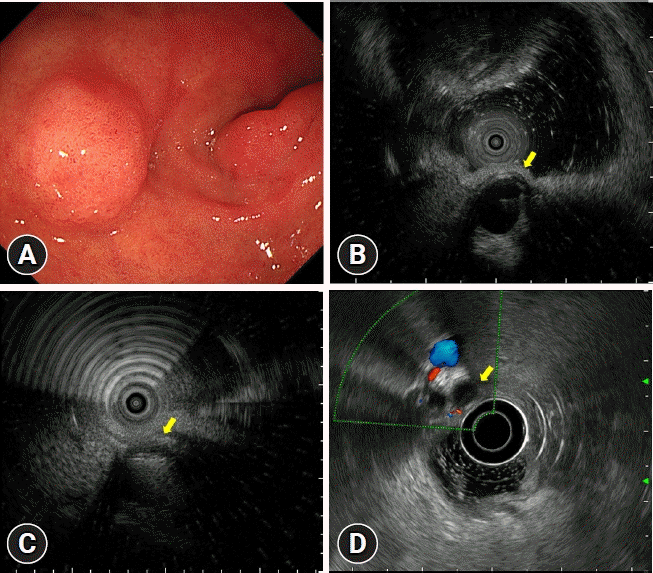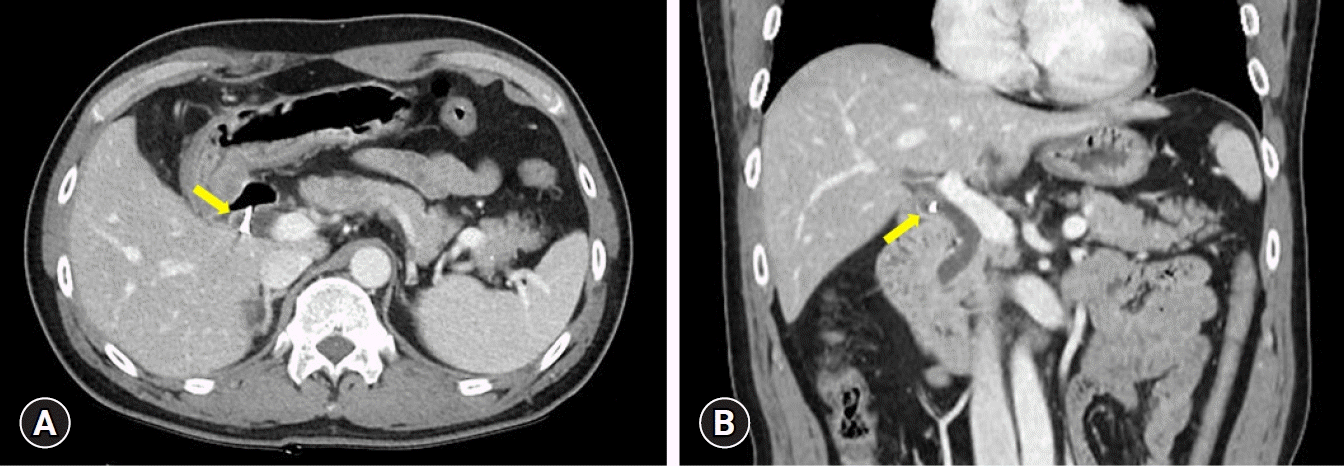A remnant cystic duct presenting as a duodenal subepithelial tumor
Article information
A 51-year-old man was referred to our institution because of a subepithelial tumor (SET) of the duodenum, which was detected incidentally during esophagogastroduodenoscopy (EGD). Twenty years earlier, he had undergone a cholecystectomy because of cholelithiasis. During EGD, an SET-like lesion, covered by normal duodenal mucosa, was observed in the anterior wall of the duodenal bulb (Fig. 1A). Endoscopic ultrasonography (EUS) using a 20-MHz catheter probe (UM3D-DP20-25R; Olympus) revealed a 0.8×0.6 cm-sized anechoic lesion with hyperechoic suture material outside the duodenal wall (Fig. 1B, C), which was connected to the common bile duct. No Doppler flow was detected by 7.5-MHz conventional EUS using a radial echoendoscope (GF-UE260-AL5; Olympus) (Fig. 1D, Video 1). Abdominal computed tomography scans also showed a remnant cystic duct with suture material (Fig. 2). Therefore, the lesion was diagnosed as a duodenal SET-like lesion caused by a remnant cystic duct.

Endoscopic ultrasonography (EUS) findings. (A) A 1-cm-sized subepithelial lesion covered by normal duodenal mucosa is observed in the anterior wall of the duodenal bulb. (B, C) EUS using a 20-MHz catheter probe reveals a 0.8×0.6 cm-sized anechoic lesion with hyperechoic suture material (arrow) outside the duodenal wall. (D) Conventional EUS (7.5 MHz) reveals that the anechoic lesion was connected to the common bile duct and had no Doppler flow (arrow).

Abdominal computed tomography reveals a remnant cystic duct with suture material (arrows). (A) Transverse section view. (B) Coronal section view.
A remnant cystic duct occurring after cholecystectomy can cause an SET-like lesion in the duodenum, particularly when the SET-like lesion is in the anterior side of the duodenal bulb in patients with a history of cholecystectomy. Although it is very rare, adenocarcinoma can arise from such a remnant cystic duct.1 Detailed examination of a remnant cystic duct by EUS is necessary to avoid missing malignant tumors or stones in the remnant duct.2,3
Video
Video 1. Endoscopic ultrasonography of a duodenal subepithelial lesion.
A video related to this article can be found online at https://doi.org/10.5946/ce.2023.275.
Notes
Conflicts of Interest
Gwang Ha Kim is currently serving as a deputy editor in Clinical Endoscopy; however, he was not involved in the peer reviewer selection, evaluation, or decision process of this article. Dong Chan Joo has no potential conflicts of interest.
Funding
None.
Author Contributions
Conceptualization: GHK; Data curation: all authors; Investigation: GHK; Methodology: DCJ; Writing–original draft: GHK; Writing–review & editing: all authors.
